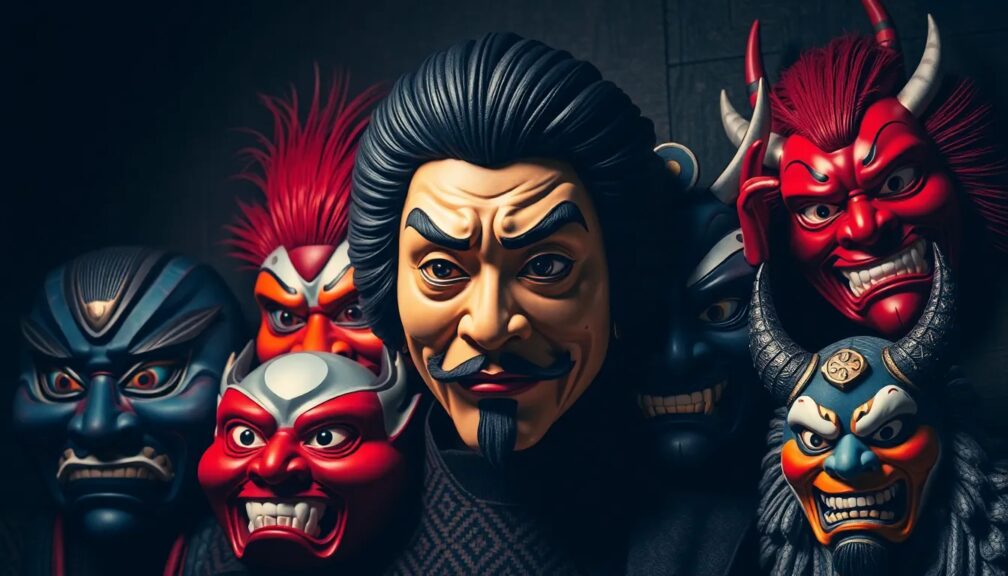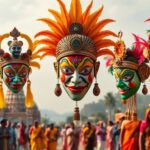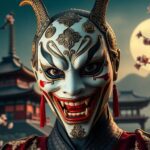The Meaning and History of Japanese Masks

In Japan, masks are not merely objects of disguise; they are profound symbols steeped in history, culture, and spirituality. Dating back centuries, Japanese masks have played a pivotal role in various traditional performances, spiritual rituals, and festivals. From the striking oni masks that evoke fear to the delicate beauty of female kabuki masks, these artifacts serve as a bridge between the past and present, allowing us to glimpse the soul of Japanese culture.
Exploring the fascinating realm of masks reveals a tapestry of meanings and uses—from the theatrical performances of Kabuki and Noh to the spiritual significance in Shinto rituals. As we delve into the world of Japanese mask history, we will uncover the diverse types of masks, their symbolic meanings, and the intricate artistry that goes into their creation. Join us on this journey to discover the unique significance of these cultural treasures.
The Historical Significance of Japanese Masks
The history of Japanese masks can be traced back to ancient rituals and performances, where they were integral to storytelling and spiritual practices. Masks were first used in Japan's prehistoric era, with archaeological evidence revealing that they were crafted from materials such as wood and clay. These early masks often represented deities or ancestral spirits, reflecting a deep-rooted belief in the supernatural.
As Japan entered the Heian period (794-1185), masks began to evolve in their artistic representation. The Noh theatre, which emerged during this time, incorporated masks that were meticulously carved and painted, designed to convey specific emotions and character traits. Each mask in Noh theatre is imbued with its unique history and meaning, often representing figures from Japanese folklore, such as gods, demons, and mythical creatures.
The Samurai era (1185-1868) also saw the rise of masks, particularly in the context of warfare. The samurai mask, known as menpo, was an essential piece of armor worn by warriors. These masks were designed not only for protection but also to intimidate enemies. They often featured exaggerated features, such as fierce expressions and long noses, which conveyed the strength and valor of the samurai who wore them.
The Artistic Craftsmanship of Japanese Masks
The creation of traditional Japanese masks is an art form that requires immense skill and dedication. Many masks are carved from wood, a practice that has been refined over generations. Craftsmen, known as mask makers, often undergo years of training to master the techniques necessary for producing these intricate pieces.
One of the most notable styles of mask-making is found in the Hannya masks, which represent female demons in Japanese folklore. These masks are characterized by their sharp horns, glaring eyes, and a mouth that reveals fangs. The craftsmanship involved in creating a Hannya mask is remarkable; artisans pay careful attention to detail, ensuring that each piece captures the essence of the character it represents.
In addition to wood, masks can also be made from materials such as paper and fabric. The Kappa mask, for example, is often crafted from lightweight materials and is used during festivals to celebrate water deities. These masks are adorned with vibrant colors and intricate designs, reflecting the lively spirit of the celebrations they accompany.
The painting of masks is another crucial aspect of their artistry. Each color used in the mask has a specific meaning; for instance, red often signifies protection, while black can represent evil or misfortune. Mask makers carefully select colors to convey the appropriate symbolism associated with the character or spirit the mask embodies.
The Role of Masks in Traditional Japanese Theatre
Japanese masks have a prominent place in traditional theatre, particularly in Noh and Kabuki performances. Noh theatre, which dates back to the 14th century, uses masks to signify the characters' emotions and status. Each mask is designed to evoke specific feelings, with the actor's movements and expressions bringing the mask to life.
In contrast, Kabuki theatre, which emerged in the early 17th century, features a more flamboyant style. The Kabuki masks used in this genre are often painted in bright colors and adorned with elaborate designs. They are designed to be visually striking, enhancing the theatrical experience for the audience. In Kabuki, masks are used to represent both male and female characters, with different styles indicating their roles. For instance, a female kabuki mask might exhibit softer lines and delicate features, while a male mask may appear more rugged and assertive.
The use of masks in these theatrical forms has profound implications. They serve not only as a tool for character representation but also as a means of connecting the audience with the spiritual world. The masks evoke emotions and provoke thought, allowing audiences to engage with the narratives on a deeper level.
Symbolism and Meaning Behind Japanese Masks
Each Japanese mask carries its unique symbolism, reflecting the cultural and spiritual beliefs of the society. For instance, oni masks, which depict demons or ogres, are often used during festivals to ward off evil spirits and bring good fortune. The oni mask meaning is deeply rooted in folklore, representing the duality of both good and evil. Different types of oni masks exist, each with its unique characteristics and meanings, such as the long nose oni mask, which symbolizes wisdom and protection.
Similarly, the tengu mask, representing a mythical creature believed to be a protector of the mountains, is used in various cultural contexts. Tengu are often depicted with red faces and long noses, and their masks are used in festivals to celebrate nature and the spirit of the wilderness. The tengu mask meaning extends beyond mere aesthetics; it embodies the reverence for the natural world that is central to Japanese culture.
In the context of spiritual practices, masks serve as vessels for communication with the divine. Japanese god masks are used in rituals to invoke the presence of deities, while protection masks are worn to safeguard individuals from harm. These masks are often imbued with prayers and blessings, reflecting the deep spiritual connection between the wearer and the mask.
Masks in Festivals and Celebrations
Japanese festivals, known as matsuri, often feature a vibrant display of masks. These celebrations are essential to preserving cultural heritage, and masks play a vital role in the festivities. For instance, the Hyottoko mask, characterized by its comical expression and big nose, is often worn during celebrations to bring good luck and humor. The hyottoko meaning is associated with the idea of prosperity and joy, making it a popular choice for festival-goers.
Another significant festival is the Obon festival, which honors deceased ancestors. During this time, various Japanese demon masks may be worn to represent the spirits of the departed, allowing participants to connect with their ancestors in a meaningful way. The masks serve as a reminder of the cycle of life and death, embodying the beliefs surrounding ancestry and spirituality.
The Kappa mask is also prevalent during festivals, where it is celebrated as a playful water spirit. Participants often don Kappa masks during river festivals, symbolizing their connection to water and its importance in Japanese culture. The vivid colors and intricate designs of these masks capture the festive spirit, creating a joyful atmosphere.
The Evolution of Masks in Contemporary Japan
As Japan continues to modernize, the role of masks has evolved, reflecting contemporary society while still honoring tradition. In recent years, there has been a resurgence of interest in Japanese mask art, with artists experimenting with new materials and designs. Contemporary artists often blend traditional motifs with modern aesthetics, creating pieces that resonate with younger generations.
Moreover, the influence of popular culture, such as anime and manga, has inspired the creation of animegao masks—masks that depict anime characters. These masks have become popular among fans, blending traditional craftsmanship with modern themes. They serve as a new form of expression, showcasing the dynamic nature of Japanese culture.
In addition to artistic evolution, masks have also found their way into various forms of entertainment, including films and video games. The portrayal of masks in these mediums often draws from traditional designs, introducing new audiences to the rich history of Japanese masks. This fusion of old and new highlights the adaptability of Japanese mask culture, ensuring its relevance in contemporary society.
Masks as a Means of Identity and Expression
Masks in Japan also serve as tools for identity exploration and self-expression. The act of wearing a mask allows individuals to step into different roles, whether in performance art or personal expression. For many, donning a mask provides the freedom to explore aspects of their personality that may not be accessible in everyday life.
In the realm of tattoo art, Japanese mask meaning tattoo designs have gained popularity, where individuals choose masks that resonate with their personal stories or beliefs. These tattoos often feature intricate details and vibrant colors, reflecting the deep cultural significance of the masks. The incorporation of masks into body art allows for a unique expression of identity, blending personal meaning with traditional symbolism.
Additionally, masks are often used in workshops and cultural events, where participants can learn about their history and significance. These experiences foster a deeper understanding of Japanese culture, encouraging individuals to connect with their heritage and explore their identities in new ways.



